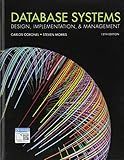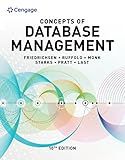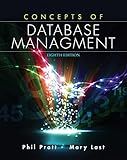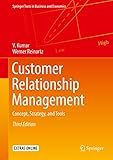Best Database Management Tools to Buy in December 2025

Database Systems: Design, Implementation, & Management



Database Systems: Design, Implementation, & Management



Concepts of Database Management (MindTap Course List)



Data Mining: Practical Machine Learning Tools and Techniques (Morgan Kaufmann Series in Data Management Systems)
- LAUNCH CAMPAIGNS SHOWCASING PRODUCT'S INNOVATIVE FEATURES AND BENEFITS.
- LEVERAGE SOCIAL PROOF WITH TESTIMONIALS AND USER-GENERATED CONTENT.
- OFFER LIMITED-TIME PROMOTIONS TO CREATE URGENCY AND DRIVE PURCHASES.



Concepts of Database Management



Customer Relationship Management: Concept, Strategy, and Tools (Springer Texts in Business and Economics)



The Enterprise Data Catalog: Improve Data Discovery, Ensure Data Governance, and Enable Innovation



The Manga Guide to Databases (The Manga Guides)



Data Mining: Practical Machine Learning Tools and Techniques (The Morgan Kaufmann Series in Data Management Systems)


To export a MySQL table to an XML file using Laravel, you can follow these steps:
- First, make sure you have Laravel and MySQL installed and configured on your system.
- Open your Laravel project in a code editor and locate the file where you want to export the MySQL table to XML.
- Import the necessary classes. Add the following at the beginning of your file:
use Illuminate\Support\Facades\DB; use Illuminate\Support\Facades\Storage; use SimpleXMLElement;
- Next, define the function in your class for exporting the table:
public function exportToXml() { $table = 'your_table_name'; // Replace with your table name $filename = 'your_file_name.xml'; // Replace with desired XML file name
$data = DB::table($table)->get(); // Retrieve all data from the table
$xmlData = new SimpleXMLElement('<?xml version="1.0" encoding="UTF-8" ?><data></data>');
foreach ($data as $row) {
$xmlRow = $xmlData->addChild('row');
foreach ($row as $columnName => $value) {
$xmlRow->addChild($columnName, $value);
}
}
Storage::disk('local')->put($filename, $xmlData->asXML()); // Store the XML file locally
return response()->download(storage\_path($filename));
}
- Replace 'your_table_name' with the name of the MySQL table you want to export and 'your_file_name.xml' with the desired name for the XML file.
- Now, you can call this function to export the table to XML from any route or controller method.
Note: Make sure you have write permissions for the storage path where you want to store the XML file.
This code uses Laravel's DB facade to retrieve data from the MySQL table and Storage facade to store the XML file. It also uses the SimpleXMLElement class to create the XML structure and save it to a file.
How to set up a Laravel project on a local server?
To set up a Laravel project on a local server, follow these steps:
- Install Dependencies: Make sure you have PHP installed on your computer. You can verify this by running the php -v command in your terminal or command prompt. Install Composer: Composer is a dependency management tool used by Laravel. You can download and install it from https://getcomposer.org/download/. Install Laravel Installer: Run the following command in your terminal or command prompt to install the Laravel installer globally: composer global require laravel/installer
- Create the Project: Open your terminal or command prompt and navigate to the directory where you want to create the Laravel project. Run the following command to create a new Laravel project: laravel new project-name Replace "project-name" with the desired name for your project.
- Start the Local Server: Navigate to the project directory by running: cd project-name Replace "project-name" with the actual name of your project. Run the following command to start the local development server: php artisan serve
- Access the Project: By default, the local server will start on http://localhost:8000. Open your web browser and visit http://localhost:8000 to see your Laravel project.
That's it! You have successfully set up a Laravel project on your local server.
How to install Laravel framework?
To install Laravel framework, you can follow the following steps:
- Prerequisites: Ensure you have PHP installed on your system. You can check this by running the command php -v in your terminal. Install Composer, a dependency manager for PHP. You can download it from https://getcomposer.org/ and follow the installation instructions for your operating system.
- Install Laravel: Open your terminal or command prompt and navigate to the directory where you want to install Laravel. Run the following command to create a new Laravel project: composer create-project --prefer-dist laravel/laravel projectName Replace projectName with the desired name for your project. This command will download and install the latest version of Laravel and its dependencies.
- Configure Environment: Copy the .env.example file in the root of your project and save it as .env. Generate the application key by running the following command: php artisan key:generate This will generate a unique key for your application.
- Test the Installation: Start the Laravel development server by running the following command: php artisan serve By default, it will run on http://localhost:8000. Open your browser and visit the URL mentioned above. If you see the Laravel welcome page, it means Laravel is successfully installed.
That's it! You have successfully installed Laravel framework on your system. You can now start building your Laravel application.
What is Laravel artisan console?
Laravel Artisan Console is a powerful command-line interface included with the Laravel framework. It provides various commands that help developers in various tasks such as generating code, managing database migrations, running tests, clearing cache, and more.
One of the main benefits of using Artisan is that it streamlines repetitive tasks and automates common development processes, saving developers time and effort. It also allows developers to create their own custom commands for specific requirements. Artisan commands are run in the terminal using the "php artisan" command followed by the desired command.
How to add custom XML tags in a Laravel XML export?
To add custom XML tags in a Laravel XML export, you can take the following steps:
- Define a custom XML structure: Determine the structure and attributes of the custom XML tags you want to add. You can specify the tags, attributes, and values according to your requirements.
- Create a new XML export file: In Laravel, create a new export file using the make:export artisan command. For example, run the following command in your console:
php artisan make:export CustomXMLExport
- Open the newly created export file: Open the generated export file (app/Exports/CustomXMLExport.php) and add the necessary namespaces as shown below:
use Maatwebsite\Excel\Concerns\WithCustomValueBinder; use PhpOffice\PhpSpreadsheet\Cell\Cell; use PhpOffice\PhpSpreadsheet\Cell\DataType;
- Implement the WithCustomValueBinder interface: To specify custom bindings for the XML values, implement the WithCustomValueBinder interface in your export file:
class CustomXMLExport implements FromCollection, WithCustomValueBinder { // ... }
- Define the bindValue method: Add the bindValue method to the export file. This method allows you to specify custom bindings for the XML tags. Use the setCellValueExplicit method of the Cell object to set the value with the desired data type:
public function bindValue(Cell $cell, $value) { if ($cell->getColumn() === 'A') { $cell->setValueExplicit($value, DataType::TYPE_STRING); } else { // Handle other custom bindings // $cell->setValueExplicit($value, DataType::TYPE_STRING); } }
- Customize the XML output: Implement the collection method to define the XML structure and populate the data accordingly. Here's an example implementation:
public function collection() { $data = [ [ 'custom_tag' => 'value', 'another_tag' => 'another value' ], // Add more data as per your requirements ];
return collect($data);
}
public function map($data): array { return [ 'custom_tag' => $data['custom_tag'], 'another_tag' => $data['another_tag'] // Map more data as needed ]; }
- Export the XML data: Now that you have defined the XML structure and data, you can export it by calling the download or store method. For example:
return (new CustomXMLExport())->download('custom.xml');
You can modify and expand these steps according to your specific needs.
What is the purpose of XML files in web development?
XML files, which stands for Extensible Markup Language, are commonly used in web development for various purposes. Here are some key purposes of XML files:
- Data storage and management: XML provides a standardized format for storing and organizing structured data. XML files are used to store and manage data in a hierarchical manner, making it easier to exchange and process information between different systems and platforms.
- Data exchange and interoperability: XML is widely used for data interchange between different systems, applications, and organizations. It enables data to be shared and processed across disparate systems, regardless of the programming language or operating system being used.
- Databases and content management: XML can be used as a data format for databases and content management systems. It allows the storage and retrieval of structured data, making it easier to manipulate and query the data within the system.
- Configuration and settings: XML is often employed for storing configuration settings and preferences. Many applications use XML files to define various settings, such as user preferences, connection strings, or application-specific configurations.
- Web services: XML is at the core of many web services standards, such as SOAP (Simple Object Access Protocol) and REST (Representational State Transfer). These standards use XML for structuring and exchanging data between different applications or services over the internet.
- Document representation: XML provides a way to structure and present complex, document-like data. It can be used for representing various types of documents, such as invoices, contracts, or scientific articles, ensuring proper organization and interoperability.
Overall, XML files play a crucial role in web development by providing a standardized and flexible method for storing, exchanging, and managing structured data in various contexts.
How to rollback a specific Laravel migration?
To rollback a specific migration in Laravel, you can follow these steps:
- First, open a terminal or command prompt and navigate to the root directory of your Laravel project.
- Run the following command to view a list of all completed migrations, along with their batch numbers:
php artisan migrate:status
- Look for the specific migration you want to rollback and note down its batch number.
- Next, run the following command to rollback migrations up to a specific batch:
php artisan migrate:rollback --step=[batch_number]
Replace [batch_number] with the batch number of the migration you want to rollback.
For example, if the migration you want to rollback is in batch number 3, the command will be:
php artisan migrate:rollback --step=3
This will rollback all the migrations in batch 3 and any subsequent migrations.
Note: If you're using Laravel 8 or later, the --step option is required. If you omit it, all migrations will be rolled back.
- Finally, you can check the status of the migrations using the migrate:status command again to verify that the specific migration has been rolled back.
Keep in mind that rolling back a migration will also revert any changes made by that migration on the database schema, so make sure to backup any important data before performing the rollback.
